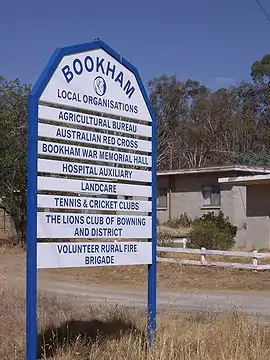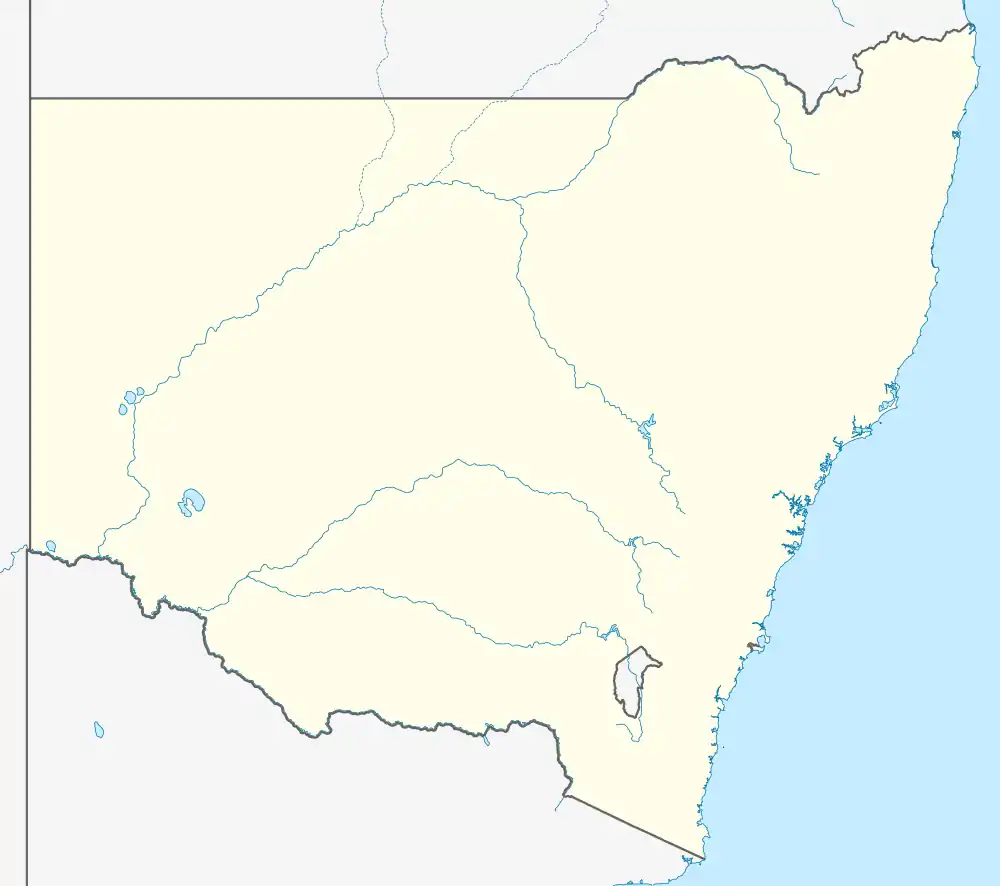Bookham, New South Wales
Bookham is a small village in the Southern Tablelands and Riverina regions of New South Wales, Australia in Yass Valley Shire. It is about 29 km west of Yass on the Hume Highway.
| Bookham New South Wales | |||||||||||||||
|---|---|---|---|---|---|---|---|---|---|---|---|---|---|---|---|
 Entering Bookham | |||||||||||||||
 Bookham | |||||||||||||||
| Coordinates | 34°48′47″S 148°38′36″E | ||||||||||||||
| Population | 161 (2016 census)[1] | ||||||||||||||
| Postcode(s) | 2582 | ||||||||||||||
| Elevation | 607 m (1,991 ft) | ||||||||||||||
| Location |
| ||||||||||||||
| LGA(s) | Yass Valley Council | ||||||||||||||
| County | Harden | ||||||||||||||
| State electorate(s) | Goulburn | ||||||||||||||
| Federal Division(s) | Eden-Monaro | ||||||||||||||
| |||||||||||||||
Overview
The general grazing area which now encompasses the village of Bookham was originally collectively called Bogolong and childhood memories of the races at Bogalong Racetrack inspired Banjo Paterson to write his poem Old Pardon the Son of Reprieve.[3]
The name change came about in 1839 when Lady Jane Franklin, wife of John Franklin, the Lieutenant Governor of Van Diemen's Land between 1837 and 1843, became the first European woman to travel overland from Port Phillip to Sydney and stayed in the area in 1839.[4]
Shortly after a design for the village at Cumbookambookinah near Bogolong was drawn up and that name was shortened either through general usage or by design to the current name of Bookham.[5]
There is an urban legend of the town once being a frequent spot for hiding police to 'book em' motorists speeding through town. Further to the legend, truck drivers would jettison some of their goods (e.g. a newspaper from a paper truck) next to the hiding spot before speeding off, hence the police focusing on cars.
Iron was smelted from locally mined iron ore at a site on Jugiong Creek approximately 3 km north of Bookham in 1874, by the Bogolong Iron Mining Company.[6] Remnants of the blast furnace still exist,[7] one of only three 19th-Century blast furnace ruins in Australia and the only one in New South Wales. It is included in the N.S.W. heritage database.[8]
Bookham Post Office opened on 1 September 1864, following the establishment of a mail run from Tumut in 1882. This involved crossing the Murrumbidgee at Roche's crossing. Bookham Post Office closed in 1993.[9] While the Post Office had a number of homes, its most recent has now been turned into a cafe, Barney's of Bookham.
There are two churches: the Uniting Church (c. 1926) and St. Columba's Catholic Church, (c. 1910) still standing in the town.[10] St Columba's Catholic Church now houses the Bookham Bazaar Pop Up offering a range of homewares, furniture, fashion, gifts and more from Australia, India, Turkey and France. The Bookham Bazaar is held during holiday periods throughout the year.
At the 2016 census, Bookham had a population of 161 people. 82.7% of people were born in Australia and 87.7% of people spoke only English at home.[1]
Gallery
 Bookham Memorial Hall.
Bookham Memorial Hall. St Columba's Catholic Church.
St Columba's Catholic Church..jpg.webp) Upper part of Bogolong blast furnace ruin
Upper part of Bogolong blast furnace ruin
References
- Australian Bureau of Statistics (27 June 2017). "Bookham (State Suburb)". 2016 Census QuickStats. Retrieved 22 June 2017.

- Travelmate Archived 24 March 2007 at the Wayback Machine
- Tourism Australia Bookham & Banjo Patterson Archived September 27, 2007, at the Wayback Machine
- ABC Tasmanian Stories
- "Bookham". Geographical Names Register (GNR) of NSW. Geographical Names Board of New South Wales.

- Jack, Ian, 1935- (1994). Australia's age of iron : history and archaeology. Cremin, Aedeen. South Melbourne: Oxford University Press. pp. 89–95. ISBN 0424001586. OCLC 30791353.CS1 maint: multiple names: authors list (link)
- Geocaching. "Geocaching - The Official Global GPS Cache Hunt Site". www.geocaching.com. Retrieved 20 August 2019.
- "Bogolong Iron Smelter Blast Furnace | NSW Environment & Heritage". www.environment.nsw.gov.au. Retrieved 20 August 2019.
- Premier Postal History, Post Office List, retrieved 11 June 2009
- Tourism Australia Bookham Churches Archived September 27, 2007, at the Wayback Machine
| Wikimedia Commons has media related to Bookham, New South Wales. |